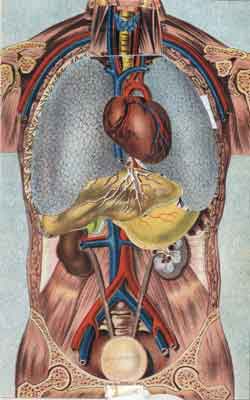| MEDICAL INTRO |
| BOOKS ON OLD MEDICAL TREATMENTS AND REMEDIES |
THE PRACTICAL |
ALCOHOL AND THE HUMAN BODY In fact alcohol was known to be a poison, and considered quite dangerous. Something modern medicine now agrees with. This was known circa 1907. A very impressive scientific book on the subject. |
DISEASES OF THE SKIN is a massive book on skin diseases from 1914. Don't be feint hearted though, it's loaded with photos that I found disturbing. |
The open flap pull apart anatomy person, revealing organs and what's behind them.
The Pop Apart Person
This would have to be the highlight of the illustrations in The Practical Home Physician anatomy wise. It's hard to believe that this type of open flap picture, which is a type we think more in terms of childrens books, served such a vital role in a health book of the 19th century. Having the anatomy of the human body so displayed, allowed the reader to open a flap and see what lies beneath that organ or muscle, thereby gaining a 3 dimensional / 3d understanding of where the organs are in relation to all the other organs! Ingenious.


First pop apart person shows the muscles covering the body, the second pop apart person shows the Heart, stomach, duodenum ( where the stomach joins into the small intestine, blue horse shoe shape ), small (narrow) intestine which eventually turns into the large large intestine and so on - some major veins (blue) and arteries (red) of the human body.


The third pop apart person shows the stomach, kidneys, liver, gall bladder (green), and bladder of the human body, while the fourth pop apart person shows the Cross section of heart and lungs of the human body, plus the stomach, liver, gall bladder, kidneys and bladder.


The fifth pop apart person shows the rib cage, stomach, kidneys, liver, gall bladder, bladder and more arteries and veins of the human body, while the sixth pop apart person shows the stomach, kidneys, bladder and more main arteries and veins of the human body.

The last pop apart person shows essentially an empty rib cage, kidneys, bladder and more arteries and veins of the human body, plus the spleen (colored black).
Although not shown, the pancreas sits horizontally behind the stomach
Please note that all the words here are mine. The pull apart person was originally included in the section on Digestive disorders, but I believe that the modern reader would expect this type of illustration to be in the anatomy section. Indeed, some of the pictures were placed, I feel, somewhat haphazardly through out the book, so I have attempted to arrange the pictures of human anatomy in better positions for easier finding.
But first, if you want to come back to this web site again, just add it to your bookmarks or favorites now! Then you'll find it easy!
Also, please consider sharing our helpful website with your online friends.
BELOW ARE OUR OTHER HEALTH WEB SITES: |
Copyright © 2000-present Donald Urquhart. All Rights Reserved. All universal rights reserved. Designated trademarks and brands are the property of their respective owners. Use of this Web site constitutes acceptance of our legal disclaimer. | Contact Us | Privacy Policy | About Us |